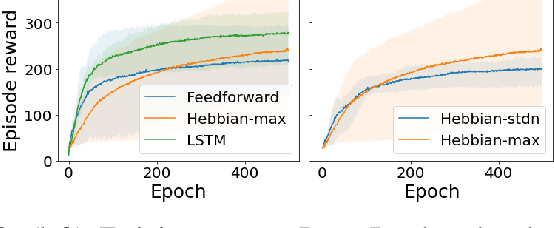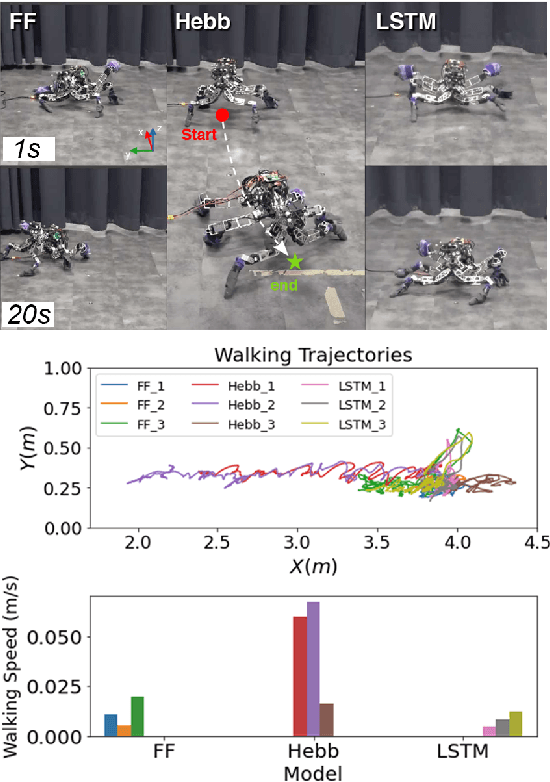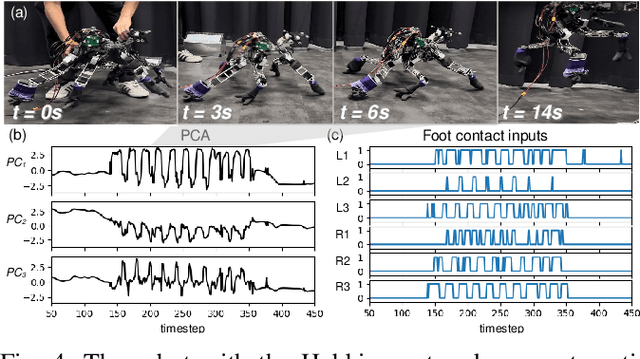Binggwong Leung
Bio-Inspired Plastic Neural Networks for Zero-Shot Out-of-Distribution Generalization in Complex Animal-Inspired Robots
Mar 16, 2025



Abstract:Artificial neural networks can be used to solve a variety of robotic tasks. However, they risk failing catastrophically when faced with out-of-distribution (OOD) situations. Several approaches have employed a type of synaptic plasticity known as Hebbian learning that can dynamically adjust weights based on local neural activities. Research has shown that synaptic plasticity can make policies more robust and help them adapt to unforeseen changes in the environment. However, networks augmented with Hebbian learning can lead to weight divergence, resulting in network instability. Furthermore, such Hebbian networks have not yet been applied to solve legged locomotion in complex real robots with many degrees of freedom. In this work, we improve the Hebbian network with a weight normalization mechanism for preventing weight divergence, analyze the principal components of the Hebbian's weights, and perform a thorough evaluation of network performance in locomotion control for real 18-DOF dung beetle-like and 16-DOF gecko-like robots. We find that the Hebbian-based plastic network can execute zero-shot sim-to-real adaptation locomotion and generalize to unseen conditions, such as uneven terrain and morphological damage.
Nature's All-in-One: Multitasking Robots Inspired by Dung Beetles
Nov 05, 2024Abstract:Dung beetles impressively coordinate their six legs simultaneously to effectively roll large dung balls. They are also capable of rolling dung balls varying in the weight on different terrains. The mechanisms underlying how their motor commands are adapted to walk and simultaneously roll balls (multitasking behavior) under different conditions remain unknown. Therefore, this study unravels the mechanisms of how dung beetles roll dung balls and adapt their leg movements to stably roll balls over different terrains for multitasking robots. We synthesize a modular neural-based loco-manipulation control inspired by and based on ethological observations of the ball-rolling behavior of dung beetles. The proposed neural-based control contains various neural modules, including a central pattern generator (CPG) module, a pattern formation network (PFN) module, and a robot orientation control (ROC) module. The integrated neural control mechanisms can successfully control a dung beetle-like robot (ALPHA) with biomechanical feet to perform adaptive robust (multitasking) loco-manipulation (walking and ball-rolling) on various terrains (flat and uneven). It can also deal with different ball weights (2.0 and 4.6 kg) and ball types (soft and rigid). The control mechanisms can serve as guiding principles for solving complex sensory-motor coordination for multitasking robots. Furthermore, this study contributes to biological research by enhancing our scientific understanding of sensory-motor coordination for complex adaptive (multitasking) loco-manipulation behavior in animals.
 Add to Chrome
Add to Chrome Add to Firefox
Add to Firefox Add to Edge
Add to Edge